Experimental Study on Bond-Slip Behavior between Corroded I-Shaped Steel and Concrete in Subsea Tunnel
Abstract
:1. Introduction
2. Experimental Program
2.1. Accelerated Corrosion Test
2.1.1. Preparation for Testing
2.1.2. Testing Procedure
2.1.3. The Relationship between the Mass Loss and Conducting Time
2.2. Push-Out Test
2.2.1. Testing Method and Specimen Preparation
2.2.2. Setup for Push-Out Test
3. Test results and Discussion
3.1. Fracture Failure Process
3.2. The Relationship between Bond Failure Load and Corrosion Ratio
3.3. Load-Slip Curve
3.4. Distribution of Bond Stress along Specimen Length
3.5. Study on Interface Damage of Corroded I-Shaped Steel and Concrete
3.6. Bond-Slip Degradation Constitutive Model Based on Damage Theory
3.6.1. Bond-Slip Constitutive Model between Non-Corroded I-Shaped Steel and Concrete
3.6.2. Bond-Slip Degradation Constitutive Model between Corroded I-Shaped Steel and Concrete
4. Conclusions
Author Contributions
Funding
Conflicts of Interest
References
- Dammyr, O.; Nilsen, B.; Gollegger, J. Feasibility of tunnel boring through weakness zones in deep Norwegian subsea tunnels. Tunn. Undergr. Space Technol. 2017, 69, 133–146. [Google Scholar] [CrossRef]
- Wang, M. Current developments and technical issues of underwater traffic tunnel—Discussion on construction scheme of Taiwan strait undersea railway tunnel. Chin. J. Rock Mech. Eng. 2008, 27, 2161–2172. [Google Scholar]
- Liao, C.; Guo, X. Key technologies in subsea tunnel construction in China. Tunn. Constr. 2008, 28, 527–532. [Google Scholar]
- Qing, S.; Xie, W.; Gao, W.; Huang, S. Innovation of key construction technology for Kiaochow Bay Submarine Tunnel with boring and blast method. J. Railw. Eng. Soc. 2011, 9, 63–69. [Google Scholar]
- Chiorean, C.G.; Buru, S.M. Practical nonlinear inelastic analysis method of composite steel-concrete beams with partial composite action. Eng. Struct. 2017, 134, 74–106. [Google Scholar] [CrossRef]
- Lacki, P.; Nawrot, J.; Derlatka, A.; Winowiecka, J. Numerical and experimental tests of steel-concrete composite beam with the connector made of top-hat profile. Compos. Struct. 2019, 211, 244–253. [Google Scholar] [CrossRef]
- Thomas, A. Sprayed Concrete Lined Tunnels; CRC Press: Boca Raton, FL, USA, 2008. [Google Scholar]
- Wang, J.B.; Niu, D.T.; Zhang, Y.L. Mechanical properties, permeability and durability of accelerated shotcrete. Constr. Build. Mater. 2015, 95, 312–328. [Google Scholar] [CrossRef]
- Hou, D.S.; Li, T.; Wang, P. Molecular Dynamics Study on the Structure and Dynamics of NaCl Solution Transport in the Nanometer Channel of CASH Gel. ACS Sustain. Chem. Eng. 2018, 6, 9498–9509. [Google Scholar] [CrossRef]
- Shi, X.M.; Xie, N.; Fortune, K.; Gong, J. Durability of steel reinforced concrete in chloride environments: An overview. Constr. Build. Mater. 2012, 30, 125–138. [Google Scholar] [CrossRef]
- Revie, R.W. Corrosion and Corrosion Control: An Introduction to Corrosion Science and Engineering; John Wiley & Sons: Hoboken, NJ, USA, 2008. [Google Scholar]
- Böhni, H. Corrosion in Reinforced Concrete Structures; Elsevier: Amsterdam, The Netherlands, 2005. [Google Scholar]
- Hou, L.J.; Guo, S.; Zhou, B.X.; Chen, D.; Aslani, F. Bond-slip behaviour of corroded reinforcement and ultra-high toughness cementitious composite in flexural members. Constr. Build. Mater. 2019, 196, 185–194. [Google Scholar] [CrossRef]
- Lin, H.W.; Zhao, Y.X.; Feng, P.; Ye, H.L.; Ozbolt, J.; Jiang, C.; Yang, J.Q. State-of-the-art review on the bond properties of corroded reinforcing steel bar. Constr. Build. Mater. 2019, 213, 216–233. [Google Scholar] [CrossRef]
- Zhao, W.P.; Zhu, B.R. Theoretical model for the bond-slip relationship between ribbed steel bars and confined concrete. Struct. Concr. 2018, 19, 548–558. [Google Scholar] [CrossRef]
- Jiang, C.; Wu, Y.F.; Dai, M.J. Degradation of steel-to-concrete bond due to corrosion. Constr. Build. Mater. 2018, 158, 1073–1080. [Google Scholar] [CrossRef]
- Hou, L.J.; Zhou, B.X.; Guo, S.; Zhuang, N.; Chen, D. Bond-slip behavior between pre-corroded rebar and steel fiber reinforced concrete. Constr. Build. Mater. 2018, 182, 637–645. [Google Scholar] [CrossRef]
- Wang, J.; Yin, R.; Zhu, Y.; Chen, J.; Zhang, S. Experimental Study on Corroded Steel Ban with the Center of the Recycled Concrete Bond Slip Out. Bull. Chin. Ceram. Soc. 2018, 37, 3916–3921. [Google Scholar]
- Hou, L.J.; Liu, H.; Xu, S.L.; Zhuang, N.; Chen, D. Effect of corrosion on bond behaviors of rebar embedded in ultra-high toughness cementitious composite. Constr. Build. Mater. 2017, 138, 141–150. [Google Scholar] [CrossRef]
- Lin, H.W.; Zhao, Y.X.; Ozbolt, J.; Hans-Wolf, R. The bond behavior between concrete and corroded steel bar under repeated loading. Eng. Struct. 2017, 140, 390–405. [Google Scholar] [CrossRef]
- Ma, Y.F.; Guo, Z.Z.; Wang, L.; Zhang, J.R. Experimental investigation of corrosion effect on bond behavior between reinforcing bar and concrete. Constr. Build. Mater. 2017, 152, 240–249. [Google Scholar] [CrossRef]
- Feng, Q.; Visintin, P.; Oehlers, D.J. Deterioration of bond-slip due to corrosion of steel reinforcement in reinforced concrete. Mag. Concr. Res. 2016, 68, 768–781. [Google Scholar] [CrossRef]
- Bryson, J.O.; Mathey, R.G.; Hunaiti, Y.M. Surface condition effect on bond strength of steel beams in concrete. J. ACI 1962, 59, 397–406. [Google Scholar]
- Roeder, C.W. Bond Stress of Embedded Steel Shapes in Concrete, Composite and Mixed Construction; ASCE: Reston, VA, USA, 1985; pp. 227–240. [Google Scholar]
- Hamdan, M.; Hunaiti, Y. Factors affecting bond strength in composite columns. In Proceedings of the 3rd International Conference on Steel-Concrete Composite Structures, Fukuoka, Japan, 26–29 September 1991; pp. 213–218. [Google Scholar]
- Yang, Y.; Guo, Z.; Xue, J.; Zhao, H.; Nie, J. Experiment study on bond slip behavior between section steel and concrete in SRC structures. J. Build. Struct. 2005, 26, 1–9. [Google Scholar]
- Shansuo, Z.; Guozhuan, D.; Yong, Y.; Maohong, Y.; Junfeng, Z. Experimental study of bond-slip performance between steel and concrete in SRC structures. Eng. Mech. 2003, 20, 63–69. [Google Scholar]
- Zheng, H.; Hu, X.; Liu, J.; Wan, H. Experimental study on bond slip behavior between section steel and concrete in partially encased composite members. Ind. Constr. 2015, 45, 183–188. [Google Scholar]
- Liu, C.; Lv, Z.; Bai, G.; Yin, Y. Experiment study on bond slip behavior between section steel and RAC in SRRC structures. Constr. Build. Mater. 2018, 175, 104–114. [Google Scholar] [CrossRef]
- Chen, L.H.; Wang, S.Y.; Yin, C.; Li, S.T. Experimental study on constitutive relationship between checkered steel and concrete. Constr. Build. Mater. 2019, 210, 483–498. [Google Scholar] [CrossRef]
- Wang, Y.; Wang, C.; Zhu, D.; Xu, D.; Fu, C. Study on Performance of Bond-slip between Steel Shapes and Concrete under High Temperatures. J. Disaster Prev. Mitig. Eng. 2016, 36, 362–366. [Google Scholar]
- Sokolnikoff, I.S. Mathematical Theory of Elasticity; R.E. Krieger Pub. Co.: Malabar, India, 1983; p. 476. [Google Scholar]
- Roeder, C.W.; Chmielowski, R.; Brown, C.B. Shear connector requirements for embedded steel sections. J. Struct. Eng. 1999, 125, 142–151. [Google Scholar] [CrossRef]
- Hu, H. Variational Principles of Theory of Elasticity with Applications; CRC Press: Boca Raton, FL, USA, 1984. [Google Scholar]
- Yong, Y. Study on the basic theory and its application of bond-slip between steel shape and concrete in SRC structures. Xi’an Univ. Archit. Technol. 2003. [Google Scholar] [CrossRef]
- Li, J.; Wu, J. Elastoplastic damage constitutive model for concrete based on damage energy release rates, part I: Basic formulations. China Civil Eng. J. 2005, 38, 14–20. [Google Scholar]
- Wu, J.; Li, J. Elastoplastic damage constitutive model for concrete based on damage energy release rates, part II: Numerical algorithm and verifications. China Civil Eng. J. 2005, 38, 21–27. [Google Scholar]
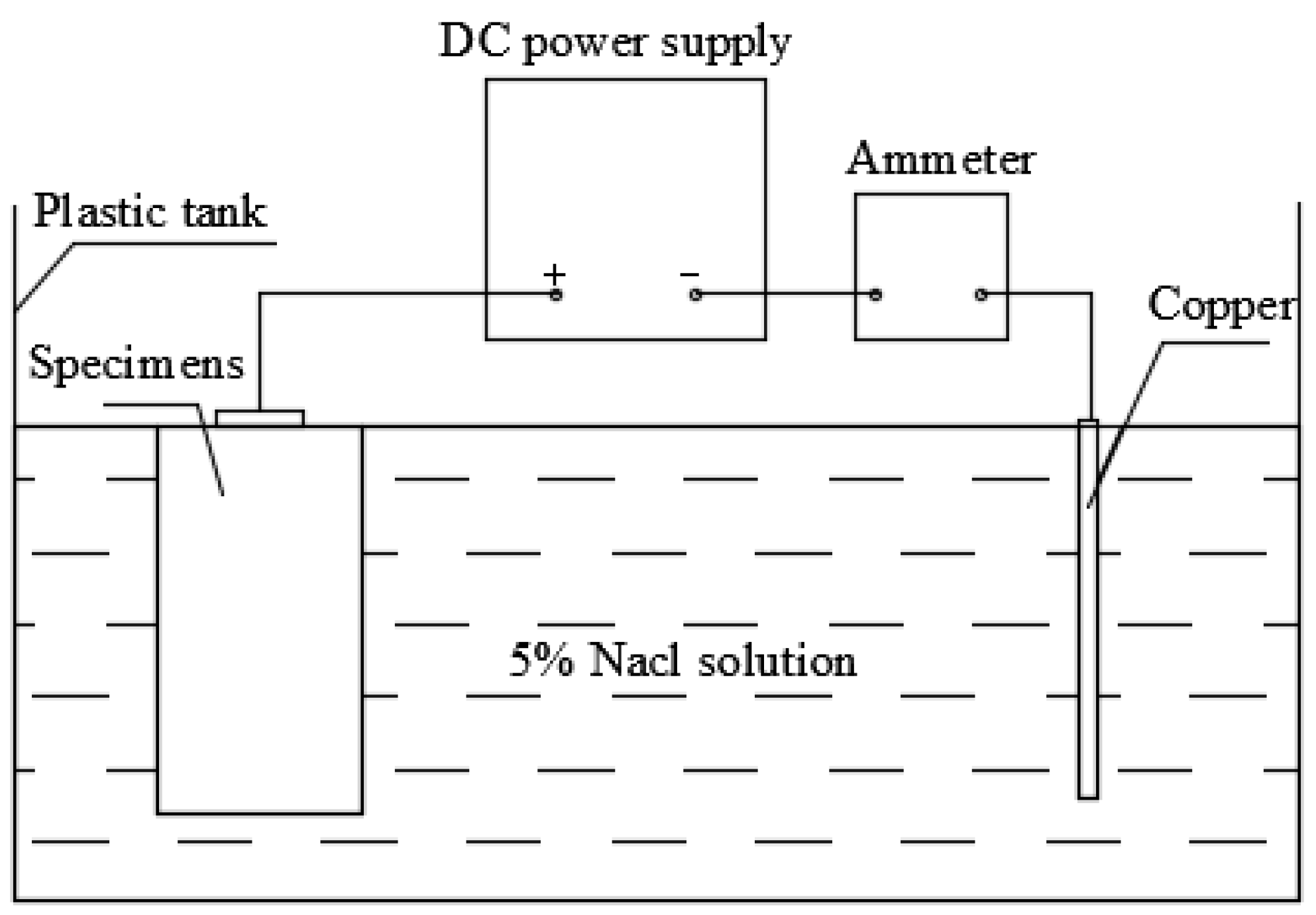

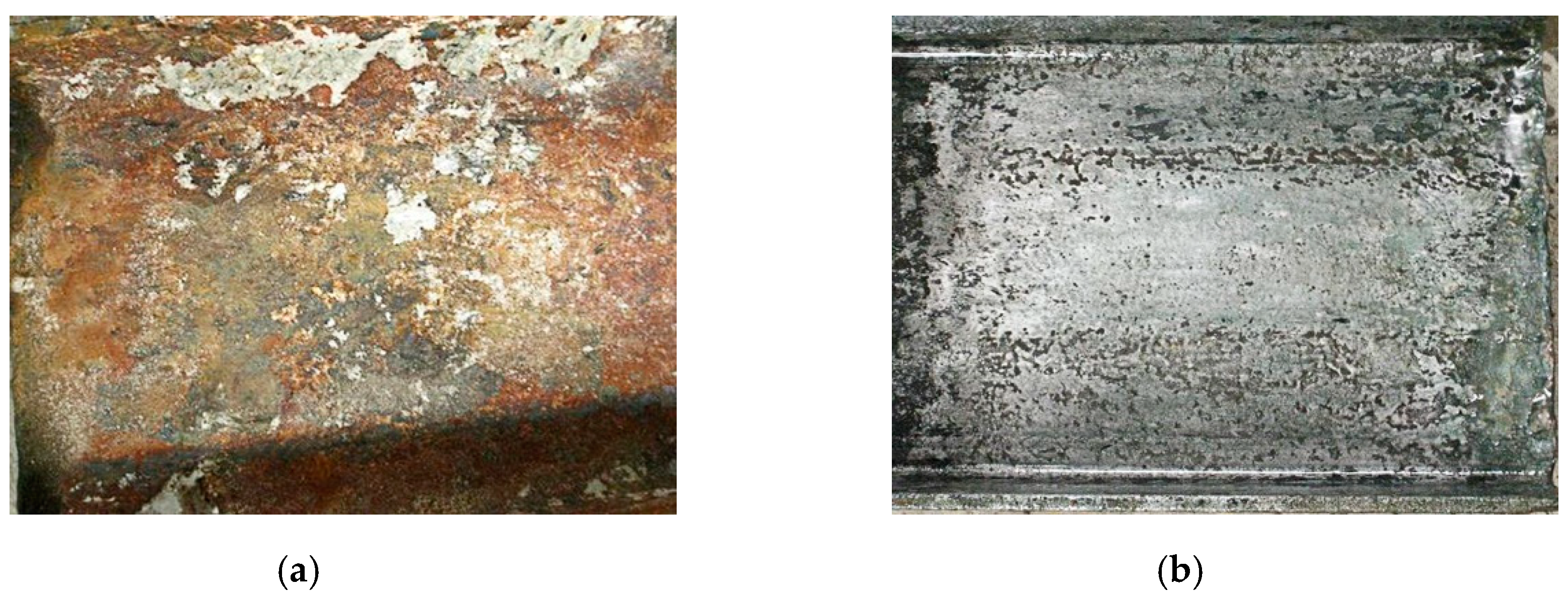
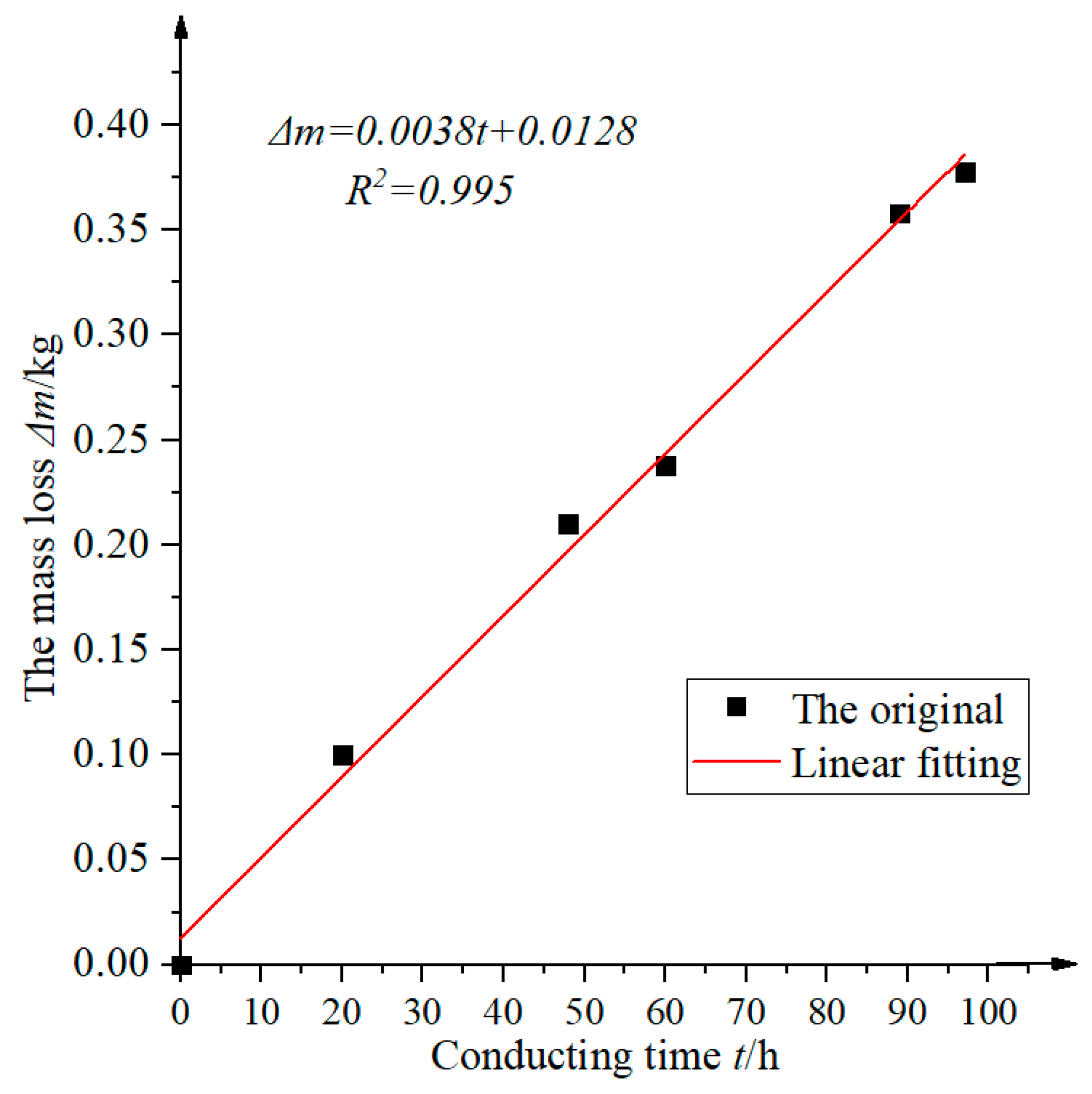

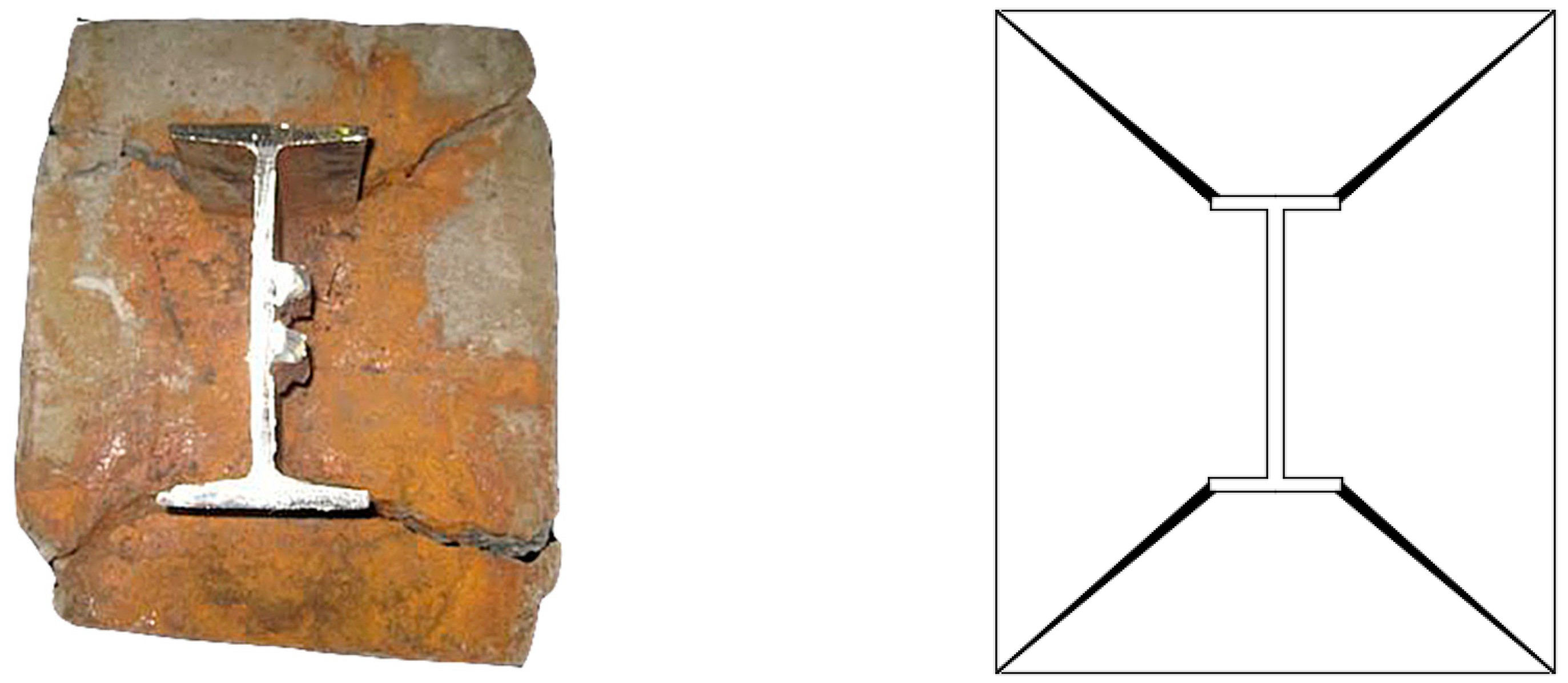


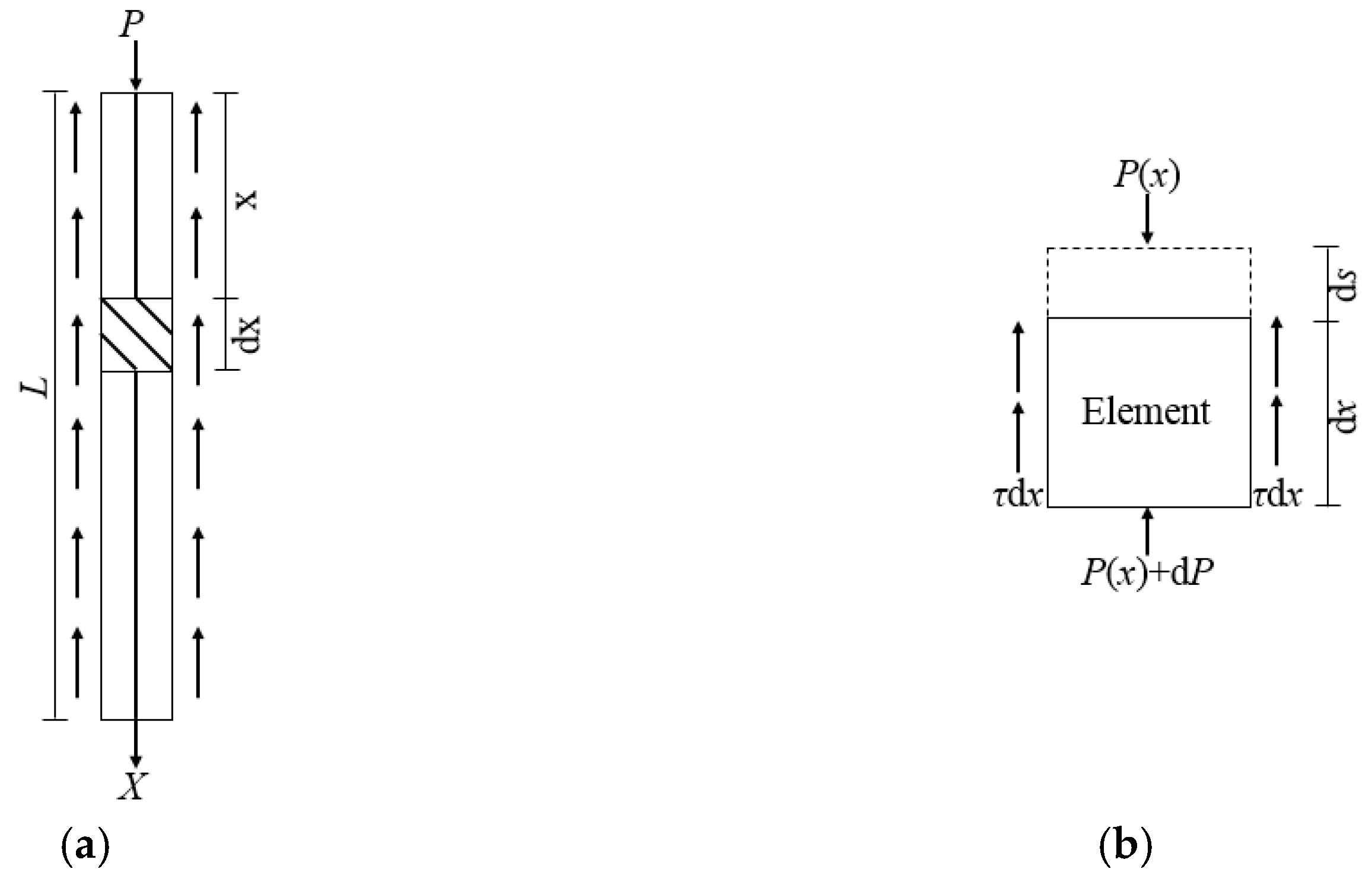
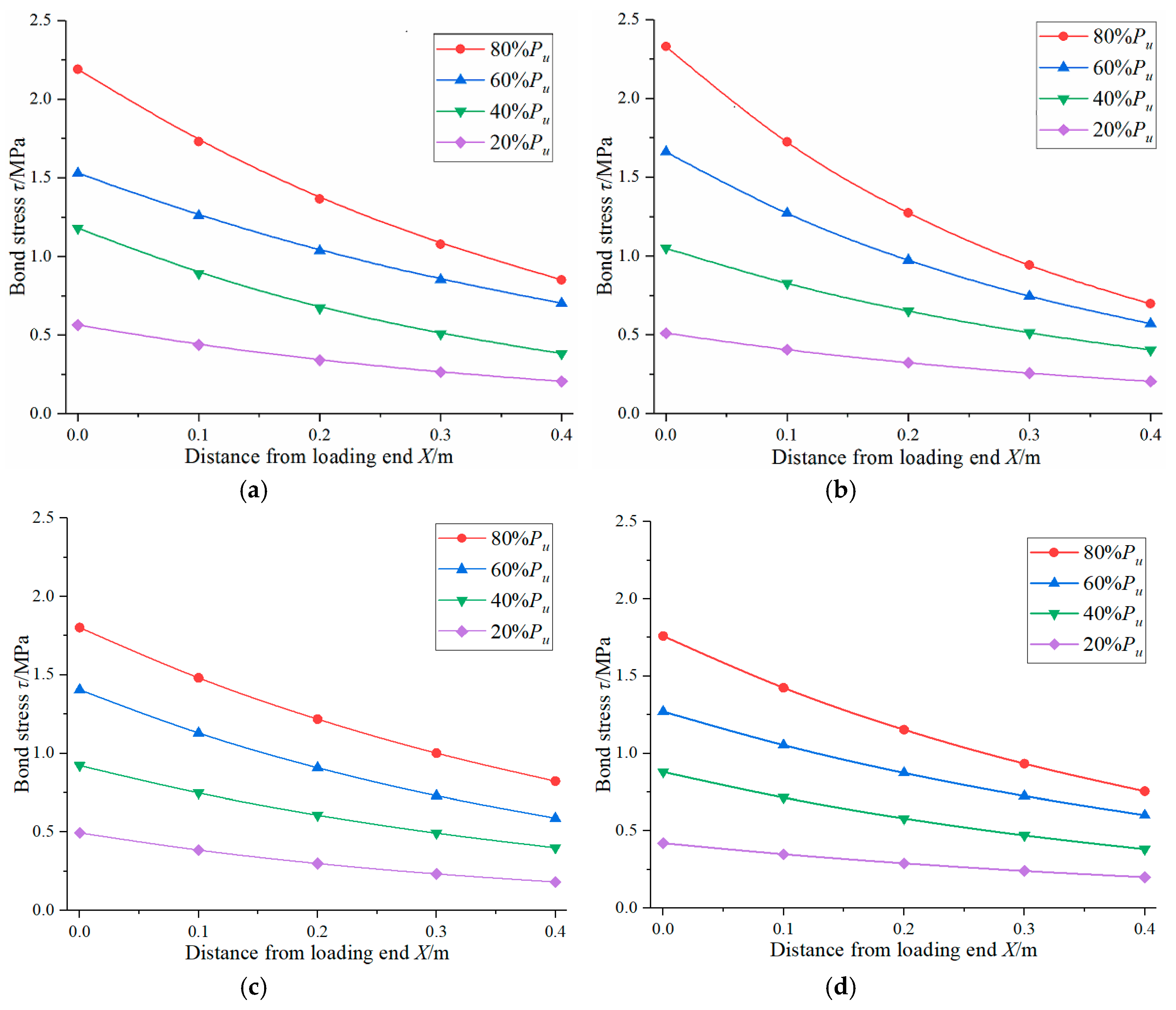
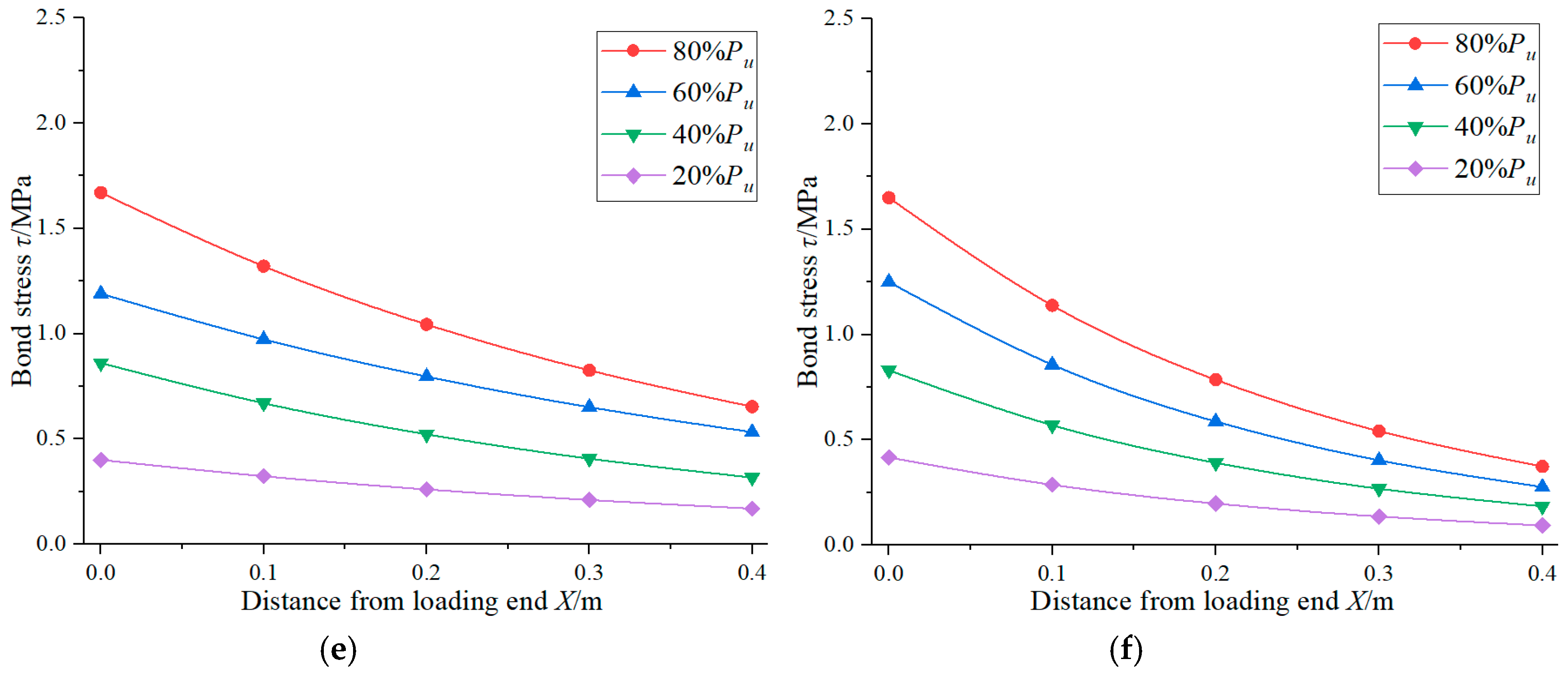
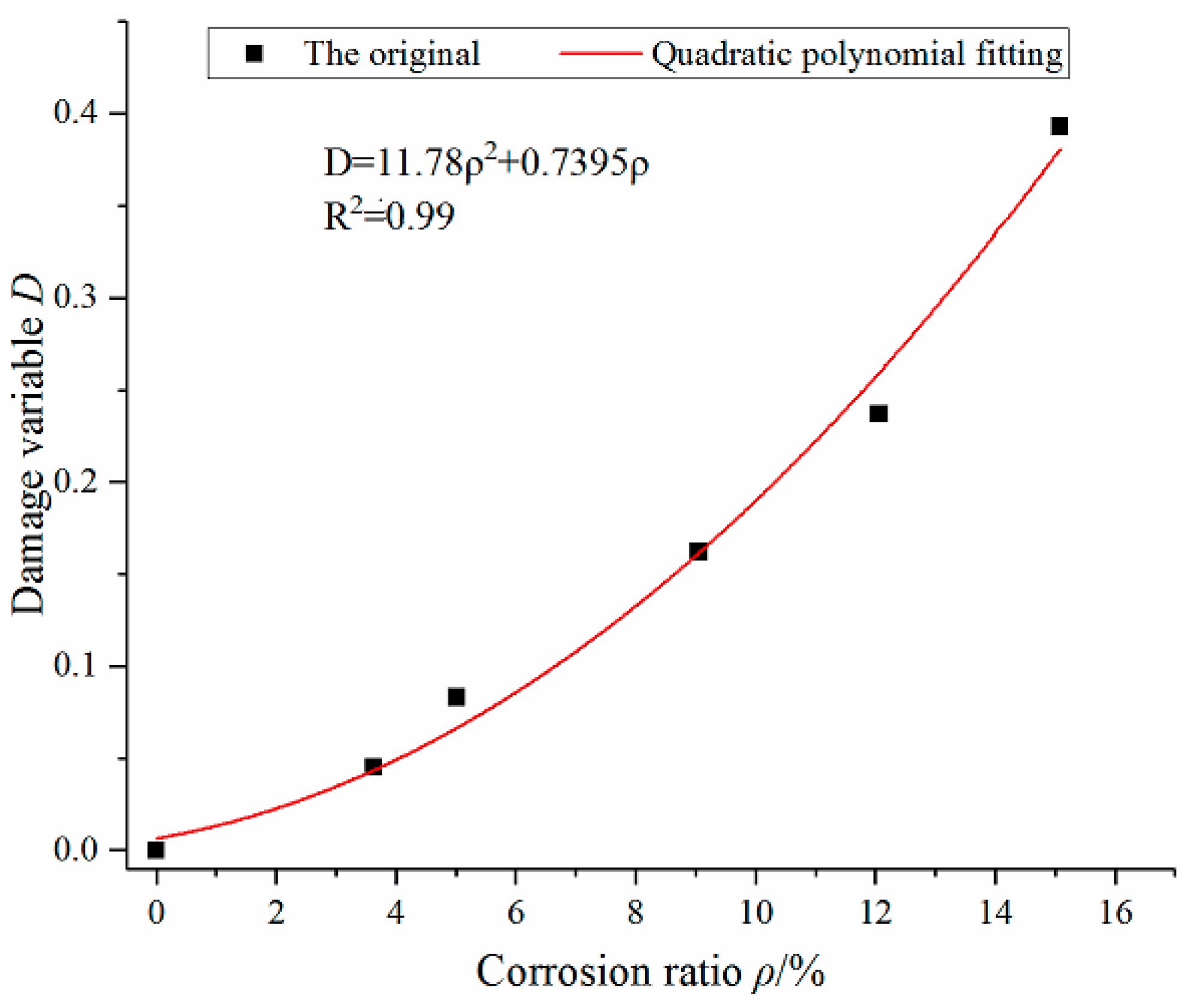
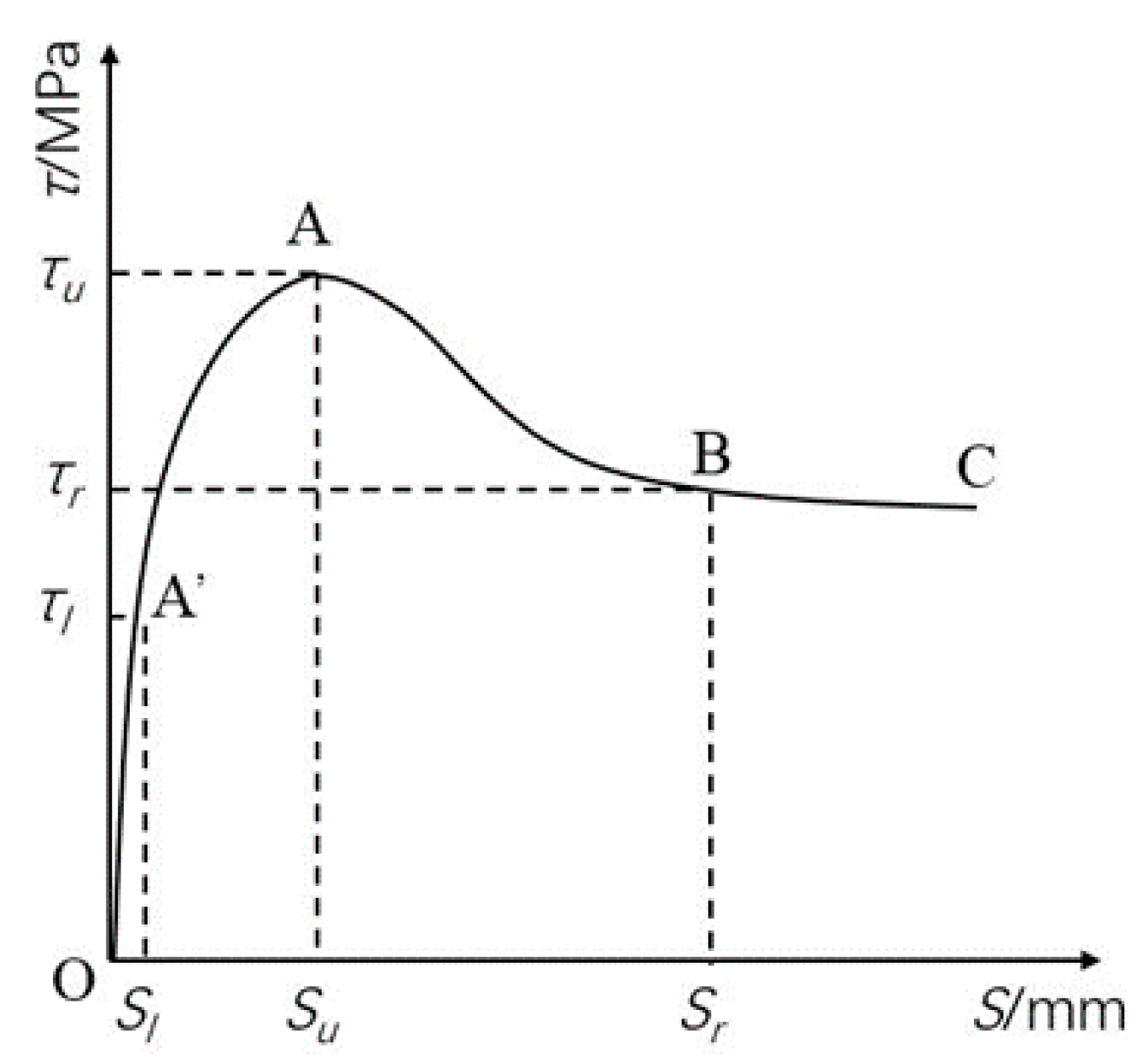
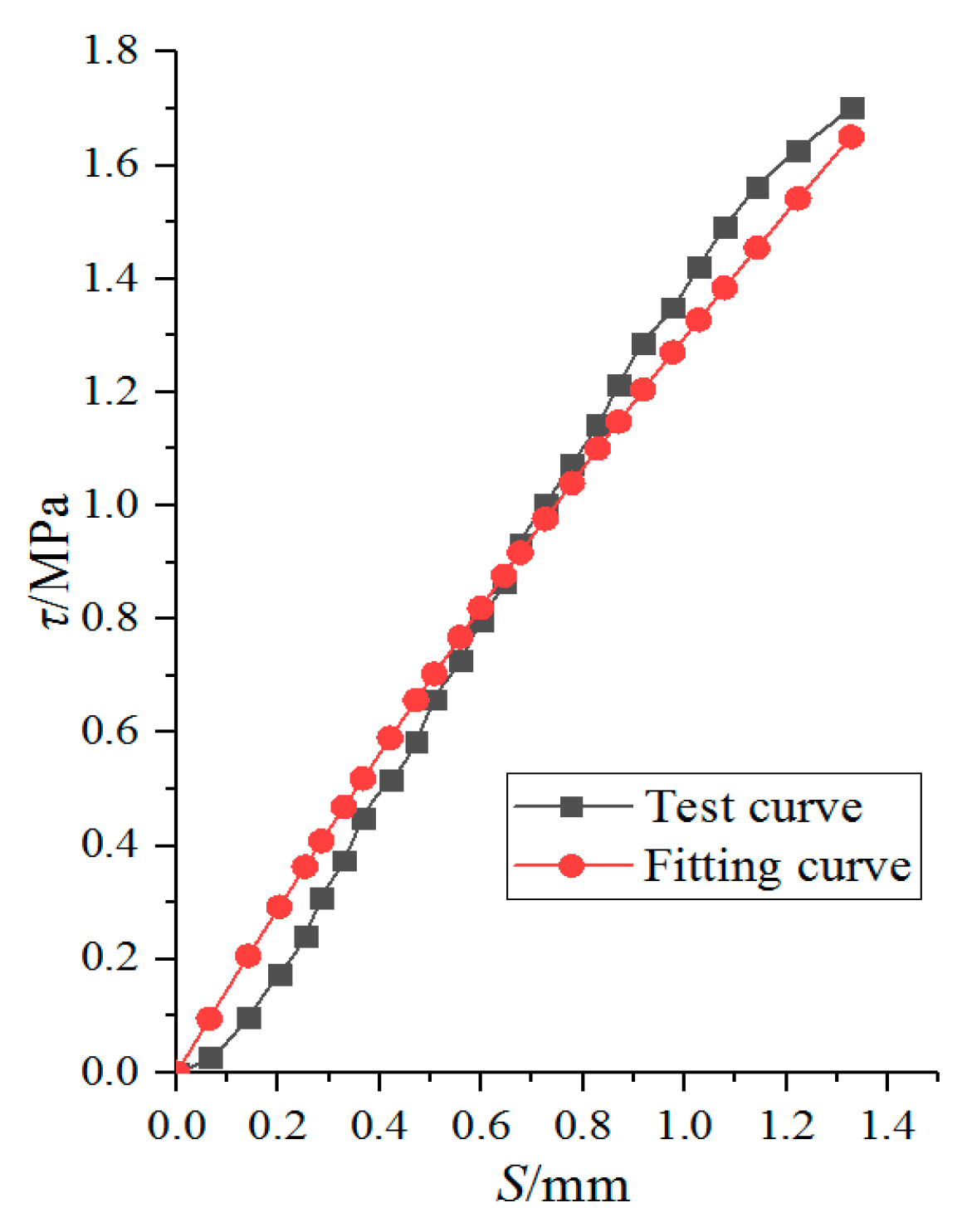
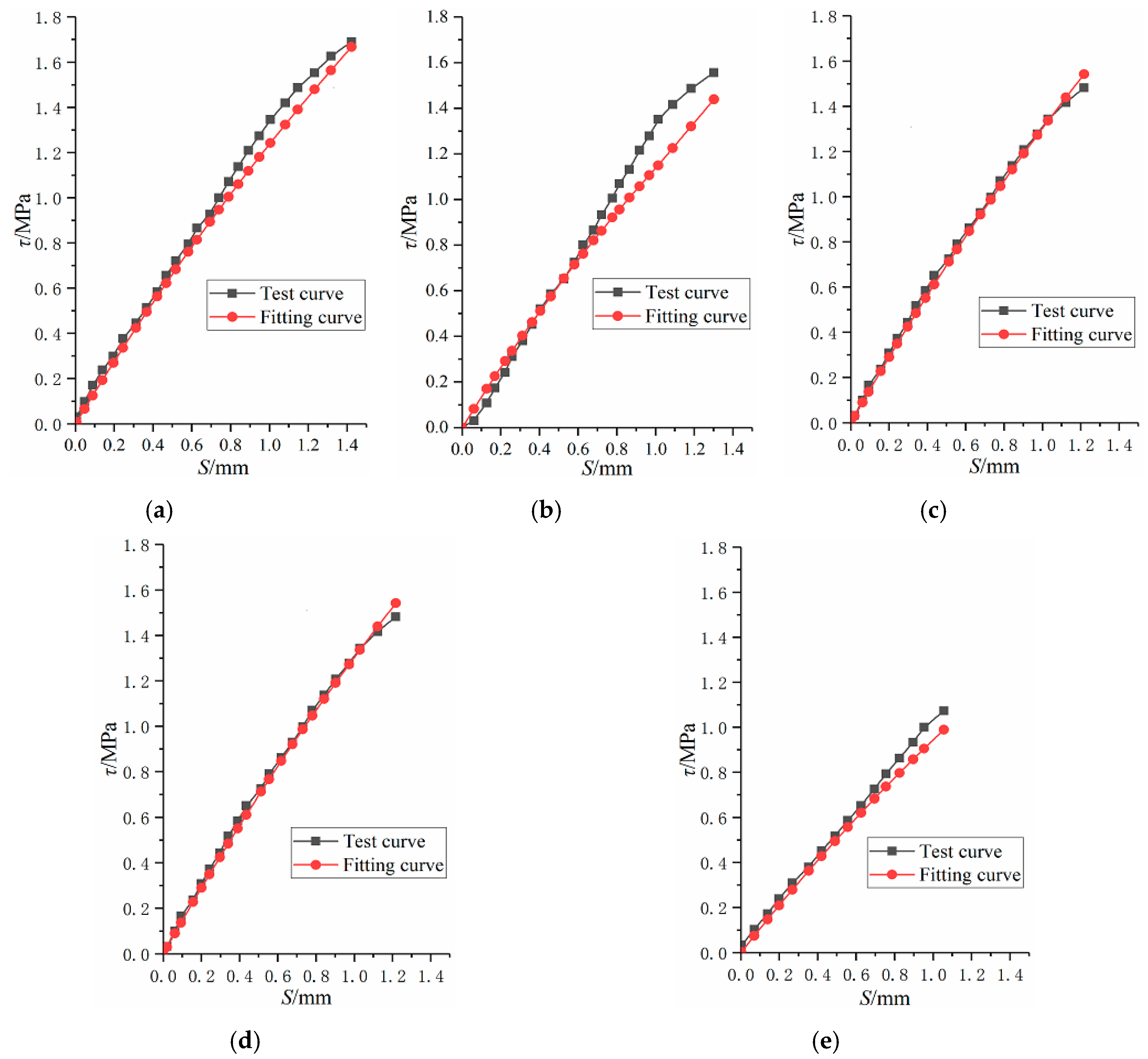
| Material Type | Model Specifications | Modulus of Elasticity E (GPa) | Poisson’s Ratio | Density (kg/m3) | Yield Strength (MPa) |
|---|---|---|---|---|---|
| I-shaped steel | NO.18 | 210 | 0.25 | 7850 | 235 |
| Concrete | C25 | 28 | 0.2 | 2200 | - |
| Serial Number | The Original Mass/kg | The Mass after Corrosion/kg | Constant Current/A | The Mass Loss/kg | Conducting Time/h |
|---|---|---|---|---|---|
| 1 | 5.79 | 5.58 | 5 | 0.21 | 48 |
| 2 | 5.713 | 5.475 | 5 | 0.238 | 60 |
| 3 | 5.763 | 5.405 | 5 | 0.358 | 89 |
| 4 | 5.723 | 5.345 | 5 | 0.378 | 97 |
| 5 | 5.95 | 5.85 | 5 | 0.1 | 20 |
| Serial Number | SRC-1 | SRC-2 | SRC-3 | SRC-4 | SRC-5 | SRC-6 |
|---|---|---|---|---|---|---|
| Conduction time/h | 0 | 72 | 100 | 180 | 240 | 300 |
| Corrosion ratio | 0 | 3.62% | 5.02% | 9.05% | 12.06% | 15.08% |
| Serial Number | Modulus of Elasticity E/(GPa) | Cross-Sectional Area A/(cm2) | The Perimeter of I-Shaped Steel Cs/(m) | Embedment Length l/(m) | ||
|---|---|---|---|---|---|---|
| Ec | Es | Ac | As | |||
| SRC-1~6 | 28 | 210 | 1569.4 | 30.6 | 0.72 | 0.4 |
| Serial Number | Corrosion Ratio ρ/(%) | Bond Failure Load Pu/kN | Damage Variable D |
|---|---|---|---|
| SRC-1 | 0 | 511 | 0 |
| SRC-2 | 3.62 | 488 | 0.045 |
| SRC-3 | 5.02 | 468 | 0.084 |
| SRC-4 | 9.05 | 428 | 0.162 |
| SRC-5 | 12.06 | 390 | 0.237 |
| SRC-6 | 15.08 | 310 | 0.393 |
© 2019 by the authors. Licensee MDPI, Basel, Switzerland. This article is an open access article distributed under the terms and conditions of the Creative Commons Attribution (CC BY) license (http://creativecommons.org/licenses/by/4.0/).
Share and Cite
Wang, M.; Zhang, Y.; Yu, L.; Dong, Y.; Tian, Y.; Zhou, G. Experimental Study on Bond-Slip Behavior between Corroded I-Shaped Steel and Concrete in Subsea Tunnel. Materials 2019, 12, 2863. https://doi.org/10.3390/ma12182863
Wang M, Zhang Y, Yu L, Dong Y, Tian Y, Zhou G. Experimental Study on Bond-Slip Behavior between Corroded I-Shaped Steel and Concrete in Subsea Tunnel. Materials. 2019; 12(18):2863. https://doi.org/10.3390/ma12182863
Chicago/Turabian StyleWang, Mingnian, Yiteng Zhang, Li Yu, Yucang Dong, Yuan Tian, and Guojun Zhou. 2019. "Experimental Study on Bond-Slip Behavior between Corroded I-Shaped Steel and Concrete in Subsea Tunnel" Materials 12, no. 18: 2863. https://doi.org/10.3390/ma12182863
APA StyleWang, M., Zhang, Y., Yu, L., Dong, Y., Tian, Y., & Zhou, G. (2019). Experimental Study on Bond-Slip Behavior between Corroded I-Shaped Steel and Concrete in Subsea Tunnel. Materials, 12(18), 2863. https://doi.org/10.3390/ma12182863





